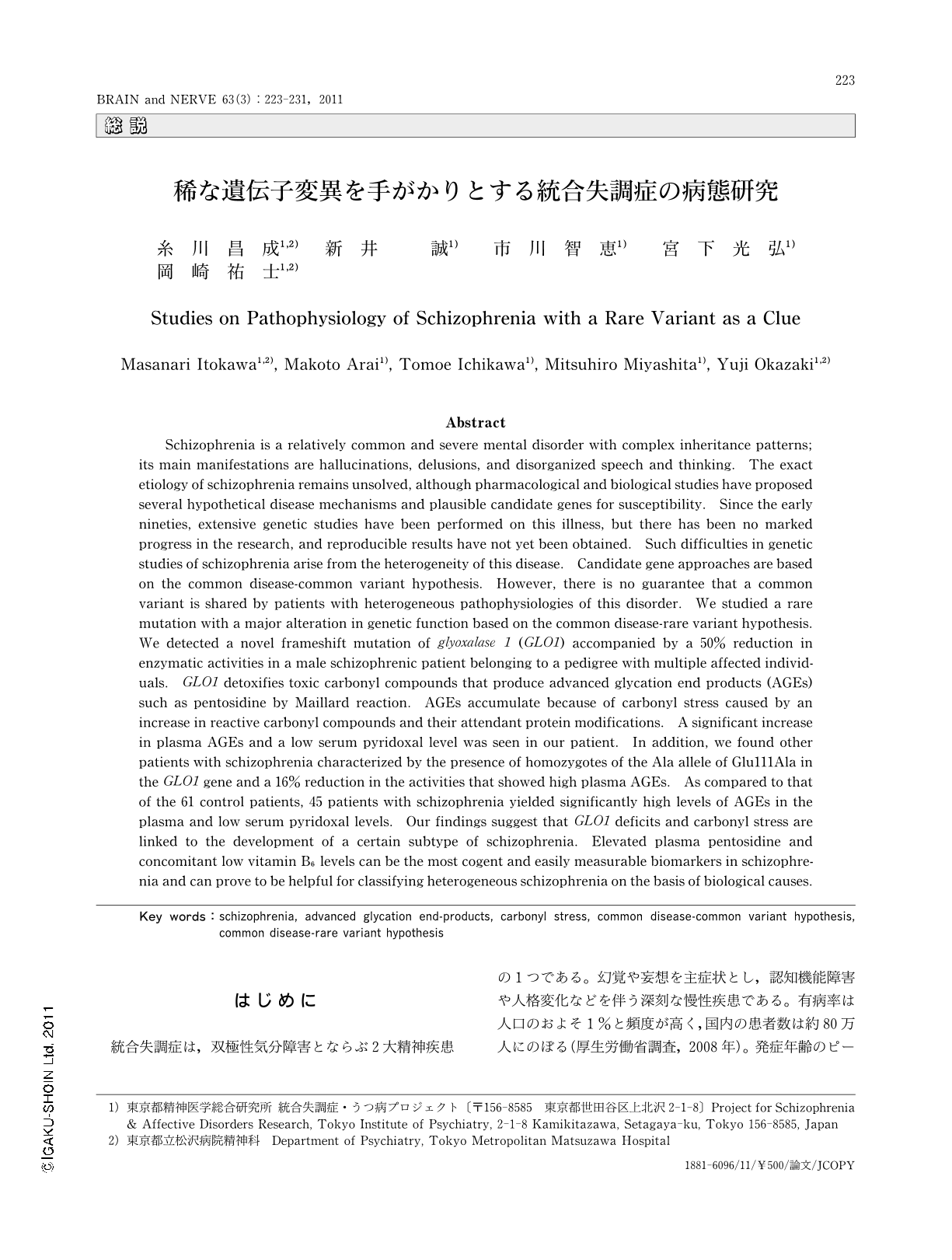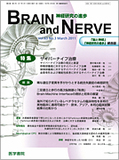Japanese
English
- 有料閲覧
- Abstract 文献概要
- 1ページ目 Look Inside
- 参考文献 Reference
はじめに
統合失調症は,双極性気分障害とならぶ2大精神疾患の1つである。幻覚や妄想を主症状とし,認知機能障害や人格変化などを伴う深刻な慢性疾患である。有病率は人口のおよそ1%と頻度が高く,国内の患者数は約80万人にのぼる(厚生労働省調査,2008年)。発症年齢のピークは17~27歳までの思春期~青年期にあり,その後は慢性に経過するため全病床の22%(1996年)がこの疾患で占められている。長期にかかる実質医療費は全呼吸器疾患と同額であり,失われた労働生産量は米国で年間460億ドル(5兆600億円)と試算され(1995年)社会的損失は極めて大きい。これほど重大な疾患でありながら,原因はいまだ不明である。
統合失調症の遺伝率はおよそ0.80であり1),発症に遺伝要因が強く関与する。そこで,統合失調症の原因解明には,病原遺伝子の同定が有効な手段と考えられ,1990年代初頭より精力的に遺伝子解析が進められてきた。しかし現在までのところ,再現性の高い成果が十分に得られていない。
統合失調症研究を難航させている要因の1つに異種性の問題がある。統合失調症は,幻覚や妄想などの主観的症状と行動観察的に把握される徴候を診断根拠とした症候群である。すなわち,単一疾患である保証はなく,研究に用いるサンプルは常に異種性の問題を内包している。これまでの研究結果に再現性が乏しく,メタ解析で確定されたリスク遺伝子のオッズ比が極めて小さいのは,この要因が寄与したと考えられる。
遺伝子研究には,以下の3つが行われてきた。(1)治療薬の標的分子や病態仮説から候補遺伝子を選んで,患者群と対照群で当該遺伝子の多型頻度を比較する関連研究,(2)家系や同胞対などを用いて染色体上に位置的に遺伝子座を絞り込む連鎖研究,(3)全染色体を対象に多型やcopy number variation(CNV)を網羅的に解析する全ゲノム関連研究(genome-wide association study:GWAS)である。以上は,common disease-common variant(CDCV)仮説注1)に基づいている。異種性の問題を考えたとき,統合失調症に疾患全体で共有される多型というものが,果たして存在するか確証はない。そこで,統合失調症の遺伝子研究が難航した要因としてCDCVの矛盾をとらえ,common disease-rare variant(CDRV)仮説注2)が提唱された。
本稿では,CDCV仮説に基づいた統合失調症の遺伝子研究を概説し,CDRV仮説で成果を挙げた自験例を紹介する。なお,自験例として紹介する研究は,東京都精神医学総合研究所および関連施設の倫理委員会の承認を得て,被験者にインフォームドコンセントと書面による同意を得て行われた。
Abstract
Schizophrenia is a relatively common and severe mental disorder with complex inheritance patterns; its main manifestations are hallucinations,delusions,and disorganized speech and thinking. The exact etiology of schizophrenia remains unsolved,although pharmacological and biological studies have proposed several hypothetical disease mechanisms and plausible candidate genes for susceptibility. Since the early nineties,extensive genetic studies have been performed on this illness,but there has been no marked progress in the research,and reproducible results have not yet been obtained. Such difficulties in genetic studies of schizophrenia arise from the heterogeneity of this disease. Candidate gene approaches are based on the common disease-common variant hypothesis. However,there is no guarantee that a common variant is shared by patients with heterogeneous pathophysiologies of this disorder. We studied a rare mutation with a major alteration in genetic function based on the common disease-rare variant hypothesis. We detected a novel frameshift mutation of glyoxalase 1 (GLO1) accompanied by a 50% reduction in enzymatic activities in a male schizophrenic patient belonging to a pedigree with multiple affected individuals. GLO1 detoxifies toxic carbonyl compounds that produce advanced glycation end products (AGEs) such as pentosidine by Maillard reaction. AGEs accumulate because of carbonyl stress caused by an increase in reactive carbonyl compounds and their attendant protein modifications. A significant increase in plasma AGEs and a low serum pyridoxal level was seen in our patient. In addition,we found other patients with schizophrenia characterized by the presence of homozygotes of the Ala allele of Glu111Ala in the GLO1 gene and a 16% reduction in the activities that showed high plasma AGEs. As compared to that of the 61 control patients,45 patients with schizophrenia yielded significantly high levels of AGEs in the plasma and low serum pyridoxal levels. Our findings suggest that GLO1 deficits and carbonyl stress are linked to the development of a certain subtype of schizophrenia. Elevated plasma pentosidine and concomitant low vitamin B6 levels can be the most cogent and easily measurable biomarkers in schizophrenia and can prove to be helpful for classifying heterogeneous schizophrenia on the basis of biological causes.

Copyright © 2011, Igaku-Shoin Ltd. All rights reserved.


